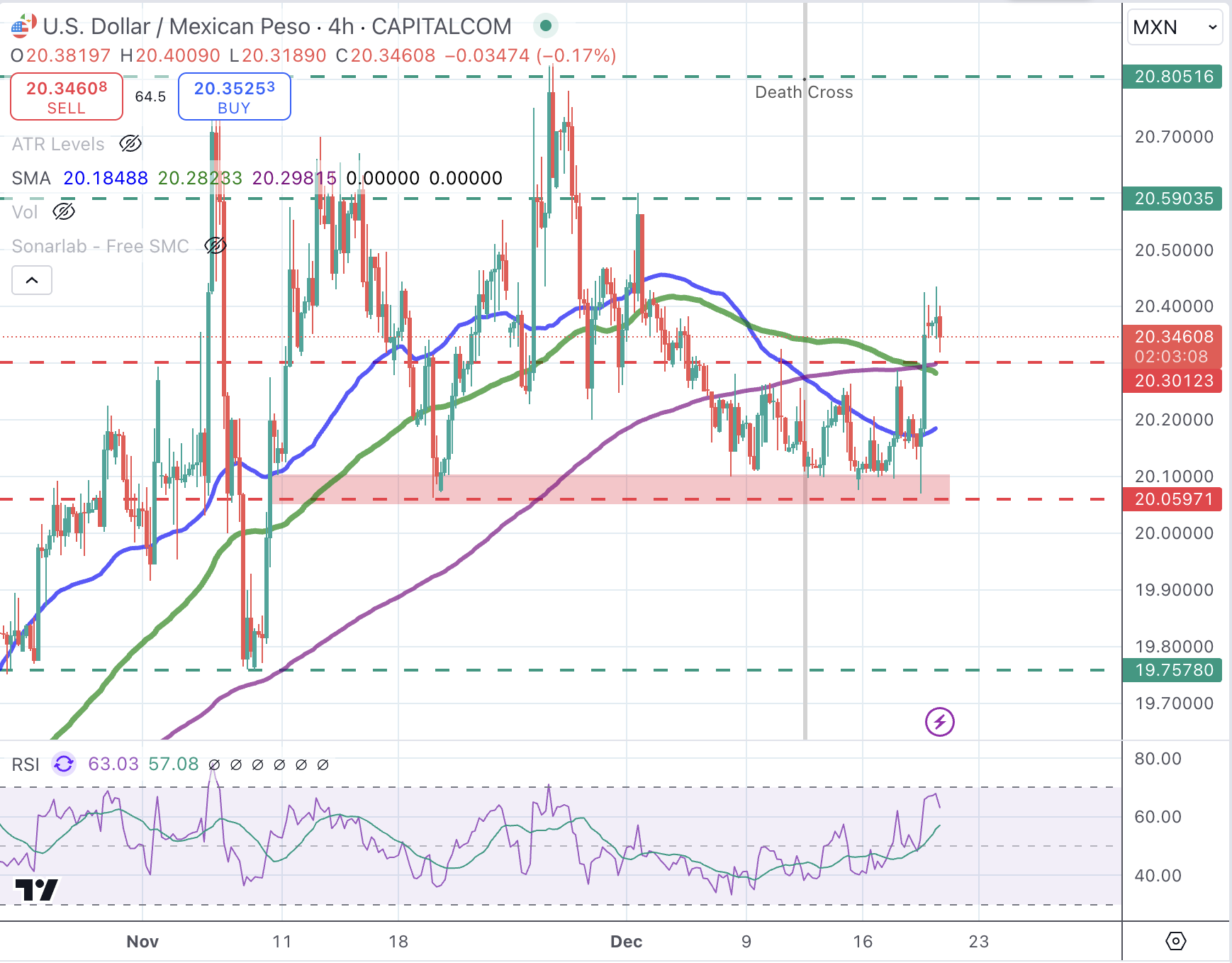- The Mexican peso cuts some losses against the US dollar with all eyes on Banxico’s decision.
- A “hawkish cut” by the Fed on Wednesday boosted the US dollar across the board.
- Technically, USD/MXN is under increasing bullish momentum above 20.30.
The Mexican Peso (MXN) is trading with marginal gains against the US Dollar (USD) on Thursday after falling to three-week lows near 20.40 the previous day. A hawkish cut by the Federal Reserve (Fed) on Wednesday, combined with uninspiring data from Mexico, keeps the MXN in a weak position ahead of the Bank of Mexico’s (Banxico) monetary policy decision.
A survey of analysts published by Citibank revealed a widespread opinion that the Mexican central bank would follow in the Fed’s footsteps and cut rates by 25 basis points (bps). Analysts stress that lower inflationary pressures and a softer economic outlook are putting pressure on Banxico to reduce borrowing costs.
The Federal Reserve cut interest rates as expected, but its monetary policy statement and Chairman Jerome Powell’s news conference leaned toward the hawkish side. The central bank raised inflation and growth expectations for next year and signaled a slower easing path.
Monetary policy divergence will likely weigh on the MXN
- The US Dollar Index (DXY) soared to test two-year highs following the Fed’s monetary policy decision, and is likely to hold firm unless US data contrasts with strong US economic projections. the Fed.
- The Bank of Mexico is widely expected to cut rates by 0.25% to 10% later on Thursday. This will be the fifth rate cut this year, with more expected in 2025.
- In the US, the Fed cut rates by 25 bps to the 4.25%-4.50% range on Wednesday, but interest rate projections for 2025 were raised to 3.9% from 3.4 %. This means two more rate cuts next year, instead of the four anticipated in September.
- The Fed raised inflation expectations for next year to 2.5% from the 2.1% estimated in September, with some analysts anticipating the impact of US President-elect Donald Trump’s inflationary policies.
- US economic growth was revised to 2.5% this year and 2.1% in 2025, from September forecasts of a stable 2.0% GDP this year and next.
- The reaction to the US central bank’s decision fueled risk aversion and sent US Treasury yields and the US dollar higher. The yield on the benchmark 10-year note soared to six-month highs above 4.50%, from lows of 4.13% last week.
- In Mexico, retail sales unexpectedly fell 0.3% in October, compared to expectations for a 0.2% increase. Retail consumption moderated its annual decline to 1.2% from 1.5% the previous month, compared to expectations for a 1.6% drop.
- According to a Citi survey, analysts expect Banxico to cut interest rates to 10.00% on Thursday and an additional 150 bps to 8.5% next year.
- The same survey reveals that market analysts expect the US dollar to appreciate to 21.00 Mexican pesos next year, with the Mexican economy slowing to annual growth of 1.6% in 2024 and 1.2% in 2025 .
Mexican Peso Technical Outlook: USD/MXN Breaks Higher, 20.60 Resistance Comes into Focus
USD/MXN has broken above the top of the horizontal channel of the last two weeks at 20.30 and is consolidating gains below the 20.40 area, with the December 2 high at 20.60 in sight.
Technical indicators are showing increasing bullish momentum, with price action above the 100 simple moving average (SMA) on the 4-hour chart and the relative strength index (RSI) still below overbought levels.
Support levels are at the top of the last two-week channel at 20.30, ahead of the key 20.00 level. To the upside, resistance is at the aforementioned 20.60, before the highs of November 6 and 26 at 20.80.
USD/MXN 4-hour chart

Mexican peso FAQs
The Mexican Peso (MXN) is the most traded currency among its Latin American peers. Its value is largely determined by the performance of the Mexican economy, the policy of the country’s central bank, the amount of foreign investment in the country and even the levels of remittances sent by Mexicans living abroad, particularly in the United States. . Geopolitical trends can also affect the MXN: for example, the nearshoring process (or the decision by some companies to relocate manufacturing capacity and supply chains closer to their home countries) is also seen as a catalyst for the currency. Mexican, as the country is considered a key manufacturing center on the American continent. Another catalyst for the MXN is oil prices, as Mexico is a key exporter of the raw material.
The main objective of Mexico’s central bank, also known as Banxico, is to keep inflation at low and stable levels (at or near its target of 3%, the midpoint of a tolerance band between 2% and 4%. %). To do this, the bank establishes an appropriate level of interest rates. When inflation is too high, Banxico will try to control it by raising interest rates, which makes borrowing more expensive for households and businesses, thus cooling demand and the economy in general. Higher interest rates are generally positive for the Mexican Peso (MXN) as they lead to higher yields, making the country a more attractive place for investors. On the contrary, lower interest rates tend to weaken the MXN.
The publication of macroeconomic data is key to evaluating the state of the economy and can have an impact on the valuation of the Mexican peso (MXN). A strong Mexican economy, based on high economic growth, low unemployment and high confidence is good for the MXN. Not only does it attract more foreign investment, but it may encourage the Bank of Mexico (Banxico) to raise interest rates, particularly if this strength is accompanied by high inflation. However, if economic data is weak, the MXN is likely to depreciate.
As an emerging market currency, the Mexican Peso (MXN) tends to rise during periods of risk, or when investors perceive overall market risks to be low and are therefore eager to engage in investments that carry higher risk. . Conversely, the MXN tends to weaken in times of market turbulence or economic uncertainty, as investors tend to sell riskier assets and flee to more stable safe havens.
Source: Fx Street
I am Joshua Winder, a senior-level journalist and editor at World Stock Market. I specialize in covering news related to the stock market and economic trends. With more than 8 years of experience in this field, I have become an expert in financial reporting.







